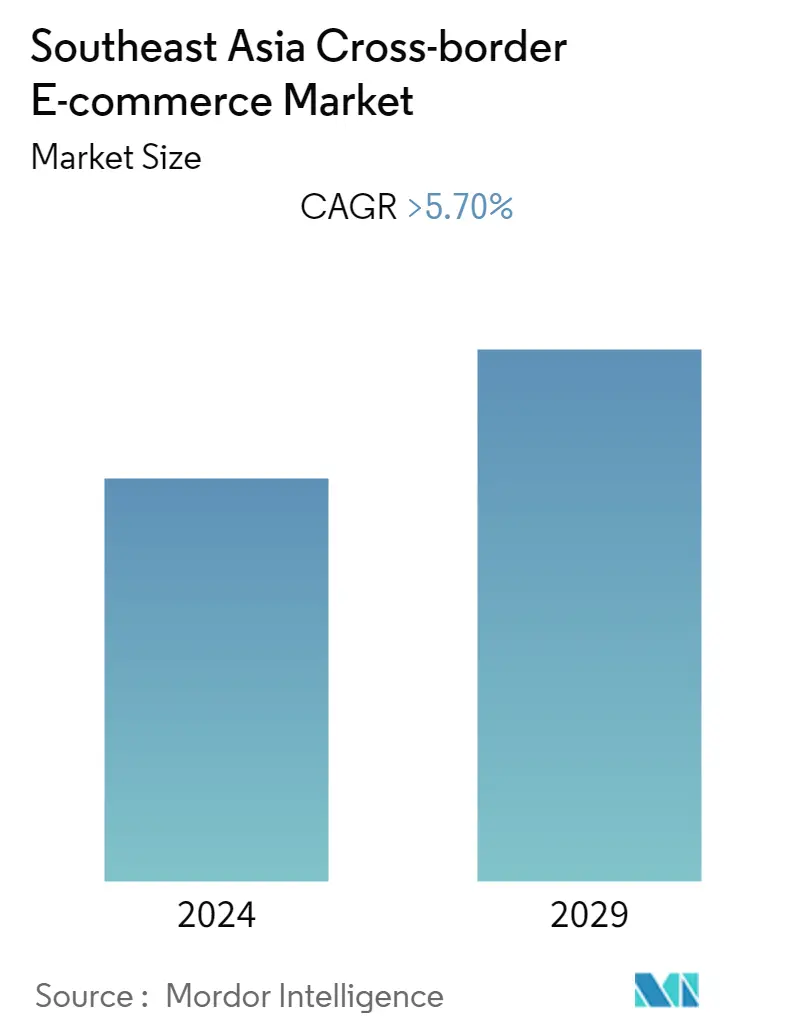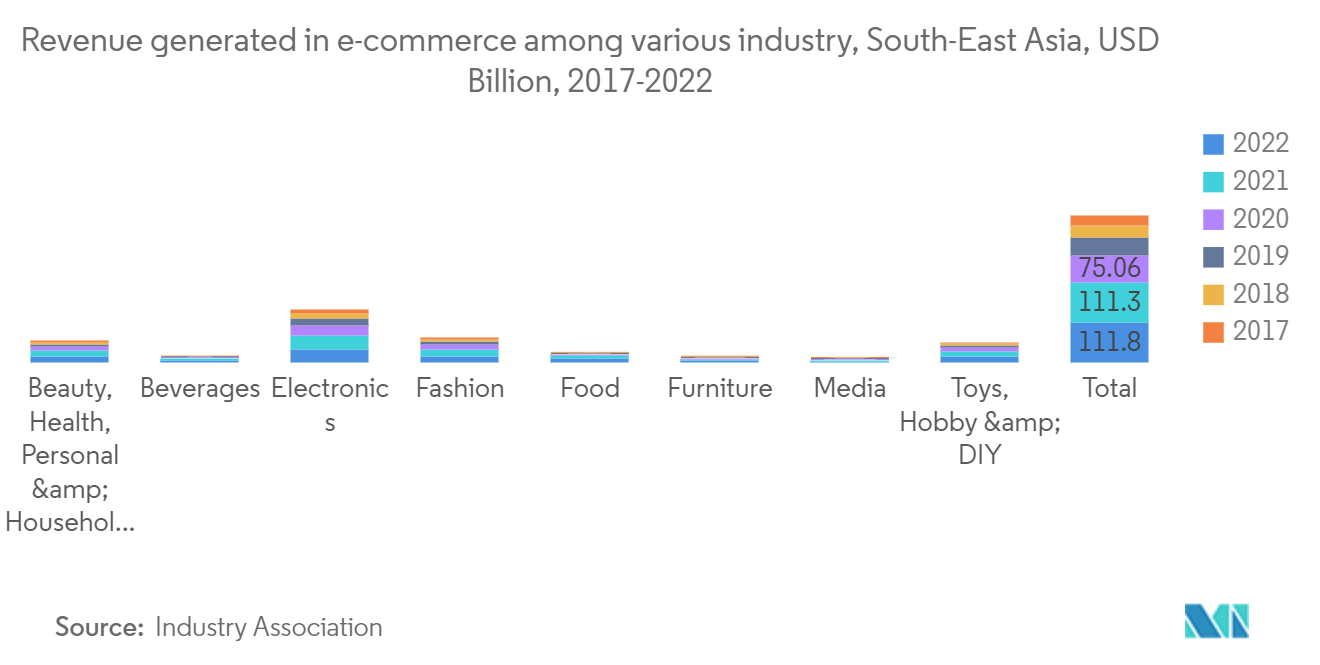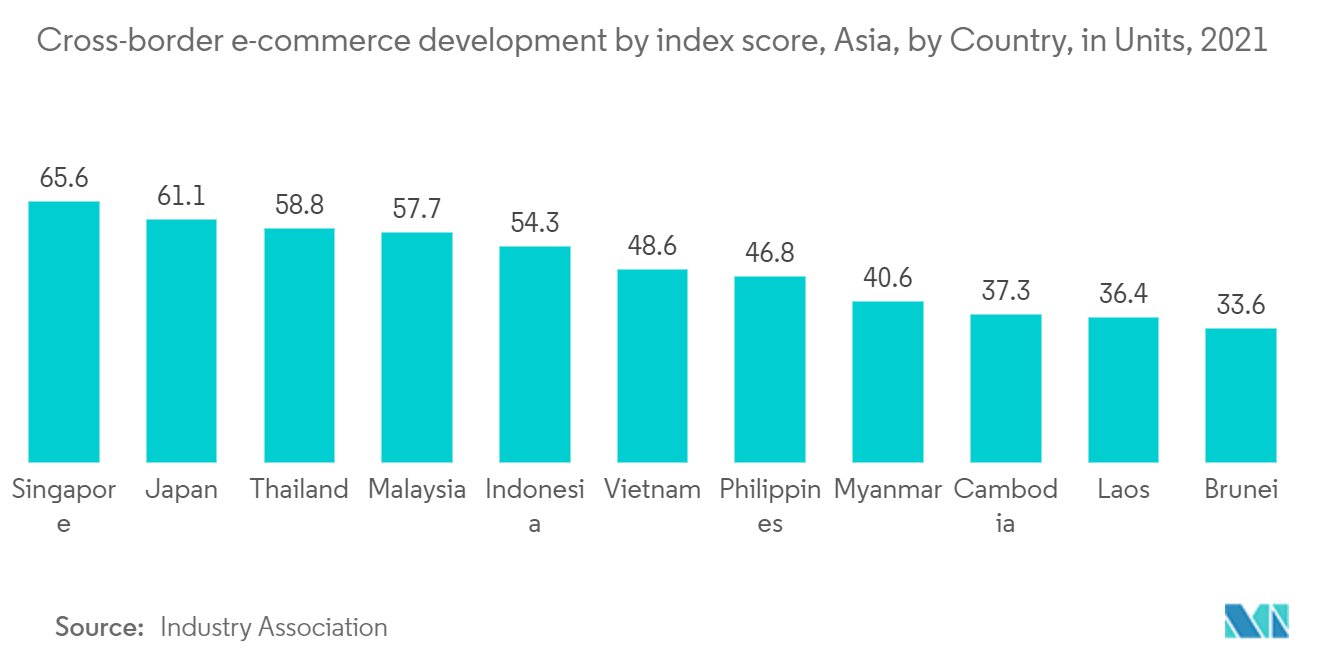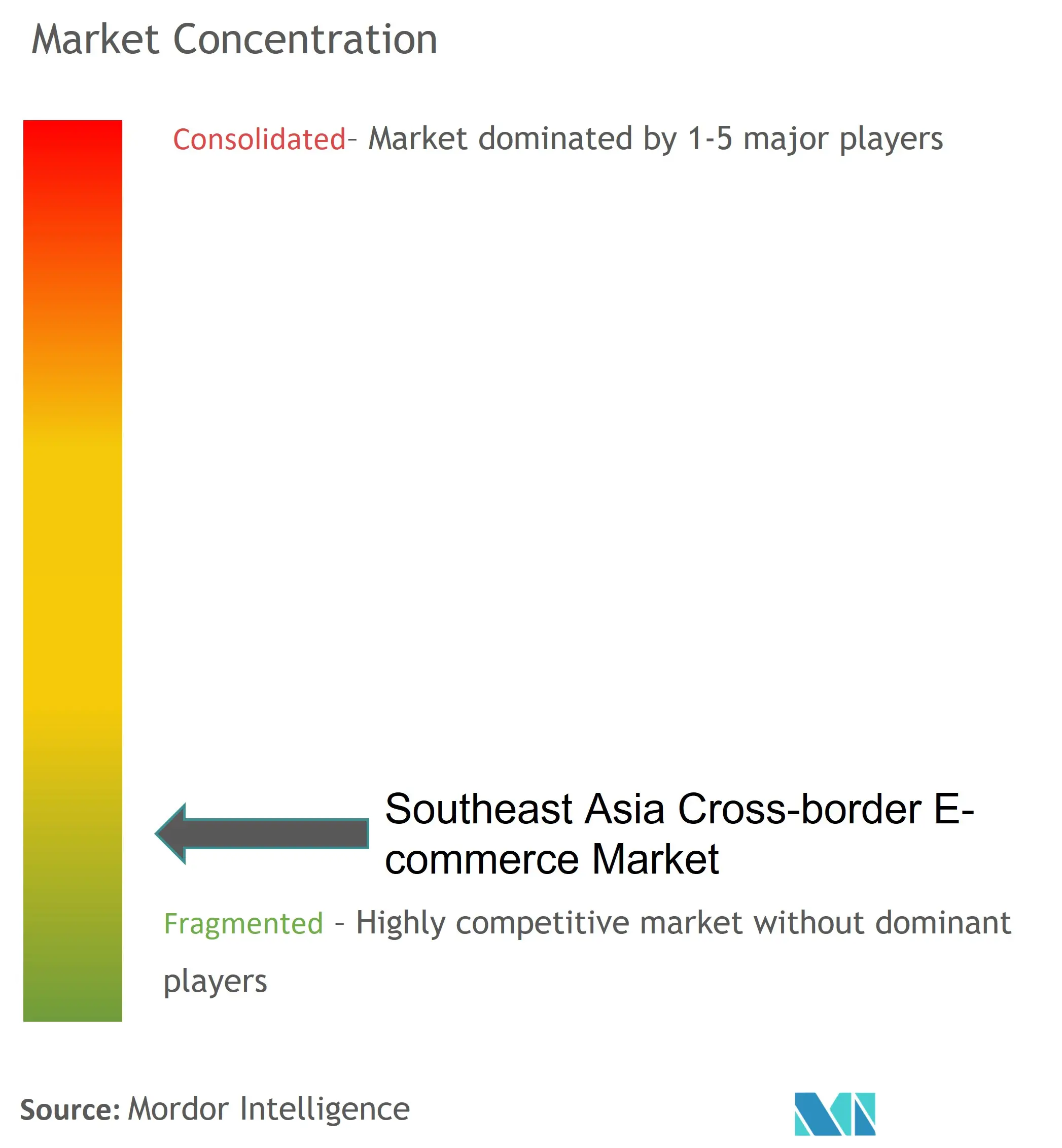Southeast Asia Cross-border E-commerce Market Size

| Study Period | 2019 - 2029 |
| Base Year For Estimation | 2023 |
| Forecast Data Period | 2024 - 2029 |
| Historical Data Period | 2019 - 2022 |
| CAGR | 5.70 % |
| Market Concentration | Low |
Major Players
*Disclaimer: Major Players sorted in no particular order |
Southeast Asia Cross-border E-commerce Market Analysis
The size of the Southeast Asia Cross-border E-commerce market is USD 13.5 billion in the current year and is anticipated to register a CAGR of over 5.7% during the forecast period The market is driven by the growth in social commerce fuelling e-commerce in the region. Furthermore, the market is driven by investment in logistics infrastructure, propelling the market growth.
- Cross-border e-commerce is the global market's future. The increasing ease of logistics has made buying or selling overseas a viable and intriguing option for people worldwide. Southeast Asia is the hotspot for global e-commerce goods. Southeast Asians have demonstrated a strong interest in cross-border trade. The following are some fascinating facts about Southeast Asian countries' participation in the cross-border e-commerce market. Singapore and Malaysia account for roughly half of Southeast Asia's cross-border e-commerce market. Thailand's e-commerce market is rapidly expanding. The Thailand 4.0 policy aims to improve internet access in every village across the country. Vietnam and the Philippines demonstrated significant cross-border potential by introducing more innovative and niche products into the market.
- Customers' demand and the viability of manufacturers sourcing products or services have been the primary drivers of emerging cross-border e-commerce. Furthermore, Southeast Asia has seen the highest population growth, with more income and handy tech in their pockets, as well as better internet connectivity; the region has more active users than the United States or Japan, paving the way for competitive e-commerce. In parallel, factors such as the desire for higher quality at a lower cost and the scarcity of products in the domestic market are driving the growing popularity of cross-border e-commerce trading. Manufacturers see these factors as an opportunity to expand into new geographies, particularly Southeast Asia, to broaden their overall clientele base for business sales.
- Cross-border E-commerce is expected to grow faster than the overall E-commerce market, particularly in Southeast Asia. Because of the crowded population, rising disposable income, internet users, smartphone usage, and infrastructure improvements, among other factors, logistics services have developed more efficiently and rapidly. Southeast Asia cross-border E-commerce is thriving, and taking advantage of niche products, low prices, high-quality goods, and other factors is driving up demand for this E-commerce market. Furthermore, cross-border E-commerce faces numerous challenges, such as high delivery costs, short delivery deadlines, currency, language, etc. Furthermore, online payments are hampered in some countries due to a lack of bank accounts.
- For example, proper product advertising and marketing are set to become major points of emphasis in 2023, as the e-commerce industry has suffered greatly from product returns and refunds. Smaller e-commerce brands will most likely invest more in current product campaigns, as accurate product representation may deter rising product return rates. Within this, e-commerce operators are likely interested in mix-media promotion or a hybrid of static and video campaigns. Smaller e-commerce brands will also be taking into account the consumer-seller relationship in 2023. E-commerce sellers may attempt to personalize a buyer's shopping experience to move away from the fast and impersonal transactions of consumer goods in the e-commerce space.
Southeast Asia Cross-border E-commerce Market Trends
This section covers the major market trends shaping the Southeast Asia Cross-border E-commerce Market according to our research experts:
Growth in E-commerce sector in the region driving the market
Southeast Asia's growth stands out even more because most other geographies will only see modest increases this year. The region's 20.6% expansion in 2022 will be the world's highest. In 2022, Latin America will be the only other region to surpass the 20% mark. Only four countries in the world will grow faster than Southeast Asia as a whole, and two of them are in the region: the Philippines and Indonesia. The Philippines, Indonesia, Vietnam, Malaysia, and Thailand will be among the top ten markets in terms of retail e-commerce sales growth.
People adore having options. When compared to Western consumers, Southeast Asian consumers prefer to see the same product listed by multiple sellers so that they can compare prices or delivery times. This is similar to their offline behaviors, where you might see a street of lamp stores or a street of butchers. That is uncommon in Western retail. People are also extremely price sensitive because their income is generally low. Playful interfaces are also appealing to consumers in the region, so gamification, vibrant colours, pop-ups, and blinking features can be found at retailers such as Shopee. Nowadays, the average consumer has more free time, so they prefer to be entertained while shopping as well.
Thailand's 18% increase in retail e-commerce sales in 2022 places it among the top ten countries expected to see the greatest increase in retail e-commerce sales growth. Several factors are driving this growth, increased internet usage, improved logistics and e-payment systems, and government policies. Thailand has one of the highest internet penetration rates in the world, at 79.5%. The country's internet user base was around 54 million in 2020, and it is expected to reach 60 million by 2026. Thailand 4.0, the Thai government's policy, included a budget for the construction of a broadband network across the country's villages.

Growth in social commerce in the region propelling the market growth
Social commerce enables brands to interact with their audiences on their preferred social media platforms throughout the entire shopping journey, from product discovery to the check-out process. It keeps people where they want to be by allowing social media users to shop while interacting with friends, reading news, and watching videos in one place. While e-commerce marketplaces remain the preferred online shopping channel among consumers in Southeast Asia, social commerce accounted for 21% of online purchases. In 2021. It saw a 102% increase in orders, a 91% increase in Gross Merchandise Value, and an 88% increase in average revenue per order in the last year alone.
The rapid growth of social commerce is due to three major factors, the first of which is the increasing use of social media in Southeast Asia. Prolonged restrictions imposed in the region to combat the spread of Covid-19 have resulted in consumers spending more time at home and turning to social media to stay connected, informed, and entertained. Another important factor is the growing demand for one-stop-shop platforms. Consumers are looking for platforms that allow them to discover and buy products. Consumers are increasingly interested in a smooth transition from discovery to purchase. Finally, online shoppers want platforms that allow them to communicate with sellers. Social commerce allows for direct communication with brands, which fosters trust and enables sellers to provide better customer service and customers to purchase more products.

Southeast Asia Cross-border E-commerce Industry Overview
The Southeast Asia Cross-border E-commerce Market landscape is fragmented, with a huge number of local and regional players dominating the market. The major players include Shoppee, Lazada, Tokopedia, Qoo10, Bukalapak, and many more. Social commerce is one of the major factors driving the market. This has created the opportunity for new players to enter the market. Regional and Local players hold a major share due to social commerce, which provides an advantage in the market and thus gives less space for global players to enter the market.
Southeast Asia Cross-border E-commerce Market Leaders
-
Shoppee
-
Lazada
-
Tokopedia
-
Qoo10
-
Bukalapak
*Disclaimer: Major Players sorted in no particular order

Southeast Asia Cross-border E-commerce Market News
- September 2022: Akulaku, a leading Southeast Asian banking and digital finance platform announced a partnership with Alipay+ that will allow Indonesian consumers to use its BNPL solution Akulaku PayLater at Alipay+'s global merchants. Alipay+, a suite of global cross-border digital payments and marketing solutions, will now support Akulaku PayLater, and merchants will be able to accept Akulaku PayLater as a payment method.
- February 2022: Razorpay has announced its first international expansion into South-East Asia, purchasing a majority stake in Curlec, a Malaysian fintech firm, for an undisclosed sum. Curlec is a Kuala Lumpur-based company that creates recurring payment solutions for modern businesses of all sizes. Razorpay's fourth acquisition in total and it's first in international waters.
Southeast Asia Cross-border E-commerce Market Report - Table of Contents
1. INTRODUCTION
- 1.1 Study Assumptions
- 1.2 Scope of the Study
2. RESEARCH METHODOLOGY
- 2.1 Analysis Method
- 2.2 Research Phases
3. EXECUTIVE SUMMARY
4. MARKET INSIGHTS DYNAMICS
- 4.1 Current Market Scenario
- 4.2 Market Overview
-
4.3 Market Dynamics
- 4.3.1 Drivers
- 4.3.2 Restraints
- 4.3.3 Opportunities
- 4.4 Value Chain / Supply Chain Analysis
-
4.5 Porter Five Forces
- 4.5.1 Threat of New Entrants
- 4.5.2 Bargaining Power of Buyers/Consumers
- 4.5.3 Bargaining Power of Suppliers
- 4.5.4 Threat of Substitute Products
- 4.5.5 Intensity of Competitive Rivalry
- 4.6 Insights and share of e-commerce among total retail sector
- 4.7 Impact of COVID-19 on the e-commerce sales
5. MARKET SEGMENTATION
-
5.1 By Business
- 5.1.1 B2B
- 5.1.2 B2C
-
5.2 By Product
- 5.2.1 Fashion and Apparel
- 5.2.2 Consumer Electronics
- 5.2.3 Home Appliances
- 5.2.4 Furniture
- 5.2.5 Beauty and Personal Care Products
- 5.2.6 Other Products (Toys, Food Products, etc.)
-
5.3 By Country
- 5.3.1 Singapore
- 5.3.2 Thailand
- 5.3.3 Vietnam
- 5.3.4 Indonesia
- 5.3.5 Malaysia
- 5.3.6 Philippines
- 5.3.7 Rest of South East Asia
6. COMPETITIVE LANDSCAPE
- 6.1 Market Concentration Overview
-
6.2 Company Profiles
- 6.2.1 Shoppee
- 6.2.2 Lazada
- 6.2.3 Tokopedia
- 6.2.4 Qoo10
- 6.2.5 Bukalapak
- 6.2.6 JD.com Inc.
- 6.2.7 ChinaAseanTrade.com
- 6.2.8 Shopify Inc.
- 6.2.9 DIYTrade.com
- 6.2.10 eBay Inc.
- 6.2.11 AliExpress
- 6.2.12 Amazon.com Inc.
- 6.2.13 Alibaba Group Holding Limited *
- *List Not Exhaustive
7. FUTURE OF THE MARKET
8. APPENDIX
** Subject To AvailablitySoutheast Asia Cross-border E-commerce Industry Segmentation
Cross-Border E-Commerce is defined as selling goods to another party from the website of a national store in another country. Cross-border e-Commerce can occur between a retailer or brand and a consumer (B2C), two businesses (B2B), or two private individuals. A complete background analysis of the Southeast Asia Cross-border E-commerce Market, including the assessment of the economy and contribution of sectors in the economy, market overview, market size estimation for key segments, emerging trends in the market segments, market dynamics, and geographical trends, and COVID-19 impact, is covered in the report.
The Southeast Asia Cross-border E-commerce Market is segmented By Business (B2B and B2C), By Product (Fashion and Apparel, Consumer Electronics, Home Appliances, Furniture, Beauty and Personal Care Products, and Other Products (Toys, Food Products, etc.)), and By Country (Singapore, Thailand, Vietnam, Indonesia, Malaysia, Philippines, and Rest of South East Asia). The report offers the market size and forecast values (USD billion) for all the above segments.
| By Business | B2B |
| B2C | |
| By Product | Fashion and Apparel |
| Consumer Electronics | |
| Home Appliances | |
| Furniture | |
| Beauty and Personal Care Products | |
| Other Products (Toys, Food Products, etc.) | |
| By Country | Singapore |
| Thailand | |
| Vietnam | |
| Indonesia | |
| Malaysia | |
| Philippines | |
| Rest of South East Asia |
Southeast Asia Cross-border E-commerce Market Research FAQs
What is the current Southeast Asia Cross-border E-commerce Market size?
The Southeast Asia Cross-border E-commerce Market is projected to register a CAGR of greater than 5.70% during the forecast period (2024-2029)
Who are the key players in Southeast Asia Cross-border E-commerce Market?
Shoppee, Lazada, Tokopedia, Qoo10 and Bukalapak are the major companies operating in the Southeast Asia Cross-border E-commerce Market.
What years does this Southeast Asia Cross-border E-commerce Market cover?
The report covers the Southeast Asia Cross-border E-commerce Market historical market size for years: 2019, 2020, 2021, 2022 and 2023. The report also forecasts the Southeast Asia Cross-border E-commerce Market size for years: 2024, 2025, 2026, 2027, 2028 and 2029.
Southeast Asia Cross-border E-commerce Industry Report
The Southeast Asia Cross-border E-commerce Market is segmented by Business (B2B and B2C), Product (Fashion and Apparel, Consumer Electronics, Home Appliances, Furniture, Beauty and Personal Care Products, and Other Products (Toys, Food Products, etc.)) and Country (Singapore, Thailand, Vietnam, Indonesia, Malaysia, Philippines, and Rest of South East Asia). The market size and forecasts are provided in values (USD billion) for all the segments. This industry analysis includes a market forecast outlook and historical overview. The report provides insights into the market size, global market, growth rate, market analysis, market share, market trends, size global, market report, market research, market growth, industry report, industry analysis, market forecast, industry overview, and market leaders.
The market data reveals significant growth rates and market segmentation, showcasing the robust industry size and market value. Industry information highlights key trends and market predictions, offering a comprehensive industry outlook and detailed market review. The report example and report pdf provide valuable industry statistics, market overview, and market outlook, reflecting the dynamic nature of the market. Research companies can leverage this information for strategic planning and to understand market segmentation and industry sales. The industry reports and industry research further emphasize the importance of market leaders and their role in shaping market trends.



